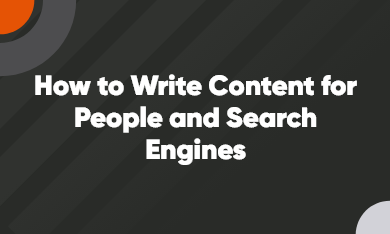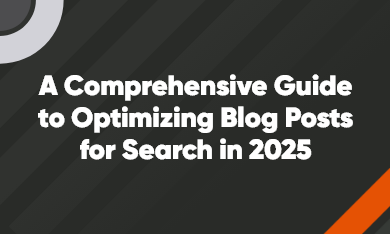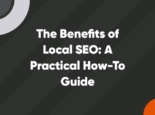
How to Write a Blog Post People Actually Read (and Google Finds)
Let’s skip the inspirational quote and get to the part you care about: how to write a blog post that doesn’t vanish into the void three minutes after publishing.
You don’t need to channel your inner Pulitzer winner. In fact, please don’t. The real secret is knowing who you’re writing for, what they’re frantically Googling at 11:42 p.m., and how to answer that question in a way that’s useful, skimmable, and doesn’t read like it was ripped from a marketing glossary.
Whether you're creating content for a Fortune 500, a three-person startup, or your friend’s niche kayaking business, here’s how to write SEO- and LLM-friendly blog posts that people actually read.
1. Start with a real topic, not just a guess
Nobody’s Googling “Insights on Holistic Innovation Across Strategic Channels.”
They are Googling “why does my website take 10 seconds to load?”
See the difference?
A good blog post starts with a real question, a real pain point, or a real curiosity your audience has. It’s how to write a blog post that’s grounded in actual search intent, not corporate filler.
Here’s how to uncover topics that matter:
- Google Autocomplete (just start typing into Google and watch the chaos unfold)
- SEMrush, Ahrefs, or Google Trends – Great for gauging what’s heating up
- Talk to your team or customers – Customer service, sales, or even social media DMs are full of blog topic inspiration
- Look for gaps in your search visibility with SEO and GEO tools
- LLMs read your Google reviews. Explore them for topics you can leverage for a blog post
If your blog topic doesn’t clearly solve a problem or answer a question, it’s not ready. Keep digging.
2. Select the right tone for your blog post
Tone isn’t just about style—it’s about trust. The wrong tone can make even the most useful content feel off. The right tone? It makes your blog feel like it was written just for the reader.
So how do you select the right tone for a blog post?
- Know Your Audience: Are they beginners or experts? B2B or B2C? Do they want a quick answer or a deep dive? The tone you use for CFOs isn’t the tone you use for backyard gardeners.
- Match the Brand, Not Just the Mood: Your blog tone should align with your overall brand voice. If your brand is bold and punchy, your content should reflect that.
- Don’t Force a Voice That Doesn’t Fit the Writer: Authenticity matters. If your team isn’t naturally sarcastic, don’t try to mimic Wendy’s Twitter account. Readers can spot a forced tone from a mile away.
Bottom line? The right tone helps your reader trust you, connect with your brand, and stay engaged.
3. Create headlines that pop (and rank)
Your headline has one job: to get people to click. But it also has a second job: to tell Google what your post is about.
A good headline does both.
Here’s how to write a blog post headline that grabs attention and supports SEO/GEO:
- Include your primary keyword. Add it in early in the title if possible
- Use numbers or parentheses to break patterns
- Add unusual or emotional language to spark curiosity
- Avoid clichés or overly broad phrases like “tips for success”
Bad: “Tips for Writing Blog Posts”
Better: “How to Write a Blog Post People Actually Read (and Google Finds)”
Think of your title like the opening line of a dating app bio. If it doesn’t make someone stop scrolling, it’s not doing its job.
4. Format like you care about people’s eyeballs
Even the best ideas can get lost in bad formatting. Big blocks of uninterrupted text? Instant bounce.
Most people aren’t reading; they’re skimming while multitasking. LLMs are doing the same thing. That’s why formatting is just as important as what you say.
Here’s how to make your post readable and scroll-friendly:
- Use clear, descriptive subheadings
- Keep paragraphs short. 2-4 lines max
- Use bulleted or numbered lists to break up info
- Add bolded text for emphasis and flow
- Include visuals, screenshots, or pull quotes if they enhance clarity
Don’t underestimate white space. You’re not dumbing anything down; you’re respecting your reader’s time.
Plus, bite-sized content is great for use in LLM responses. If you’re breaking down your points in concise paragraphs, you’re giving LLMs quick and easy content to pull from.
5. Win at SEO and GEO strategy without losing your authenticity
You don’t need to be an SEO wizard. But you do need to be intentional. Great SEO is focused on clarity, structure, and intent. You don’t need to sound robotic to get results.
Here’s how to optimize blog posts for SEO and GEO without losing your voice:
- Choose 1-2 primary keywords (e.g., “how to write a good blog post”)
- Use them in your title, URL, meta description, intro, and subheadings
- Sprinkle in semantic keywords and related phrases like “SEO-friendly blog posts,” “how to write blog posts faster,” etc.
- Link to relevant internal content. 2-4 internal links is a good baseline
- Cut down on jargon. A good GEO strategy relies on plain language explanations when providing answers to prompts
- Include external links to authoritative sources to support credibility
- Use proper headings (be sure to include an H1, add H2s for major sections, use H3s for subpoints)
- Add alt text for images that describes what’s in them using relevant terms
And above all: write like a human. If your post sounds awkward when read aloud, rewrite it. Google’s smarter than it used to be and rewards content that matches intent, not just keywords. LLMs are also using Google and Bing to source answers to questions, so make sure your content is indexed on both search engines.
If you think about your content as providing answers to questions rather than just matching keywords, you’ll be on your way to creating great content that appears in both LLM responses and SERPs.
6. Say something that has substance
This shouldn’t need saying, but it does: your blog post should make a point.
It’s not enough to just mention a topic. You need to teach something, answer something, or challenge something.
Here’s how to add value to your blog posts:
- Explain a process step-by-step
- Answer a frequently asked question in-depth
- Share an actual case study or behind-the-scenes story
- Give your unique perspective, not just what’s already ranking
- Use analogies or metaphors (in moderation) to explain complex ideas
Don’t bury the value in paragraph #17. Deliver the good stuff early and often.
If a reader gets to the end and thinks, “Okay, that was helpful”, you’ve won.
7. End with a CTA that does something
So you’ve held their attention. Now what?
Don’t leave your reader hanging. A strong CTA (call to action) gives them a clear, easy next step. It’s one of the most important parts of writing a blog post that converts.
Instead of “Thanks for reading,” try:
- “Download our full content strategy template”
- “Want blog posts like this to rank and convert? Let’s talk.”
- “Check out our post on tone of voice next—yes, it matters.”
Tailor the CTA to your goal, whether it’s lead gen, traffic, engagement, or sales. But make it specific and useful. A CTA isn’t pushy. It’s helpful. It’s saying, “Here’s what to do next.”
8. Gut check before you hit publish
Before you press that beautiful “Publish” button, run a final gut check. This is where you catch the small things that make a big difference.
Use this pre-post checklist to avoid regrets (and Google penalties):
- Primary keyword(s) in the title, URL, intro, and meta description
- Headings are real H2s, not just bolded text
- Paragraphs are short and readable
- You’re answering a real question or intent
- Internal links? Add at least two
- Your images are optimized
- The meta description sounds like a human wrote it
- You didn’t accidentally write a novel when a how-to guide would do
Bonus tip: Read it out loud. If you zone out? Rewrite until you don’t.
Blog like a human (not a content robot)
If you take nothing else away, let it be this: blogging shouldn't be focused on sounding smart. The focus should be on creating content that is clear, useful, and human.
So the next time you sit down to write:
- Start with a topic that solves a real problem
- Structure it in a way that’s scannable and easy to read
- Optimize it for SEO and GEO, but not at the cost of clarity
- Say something worth saying
- End with a CTA that respects your reader’s time
- Always review before you hit publish
Let’s make your content work smarter, not harder
Whether you’re trying to boost leads, climb search rankings, or build a content engine that drives real results, our team at Perrill can help.
We’re a full-service digital agency that blends strategy, creativity, and performance—so your blog does more than fill space. It fuels growth.
Let’s talk about turning your content into a competitive advantage.

Claire Page
Author
Claire Page
Categories
Date
Explore with AI
Join Our Newsletter


A Comprehensive Guide to Optimizing Blog Posts for Search in 2025


Is the Blogosphere Dying? Here’s What You Need to Know for 2025 and Beyond.



